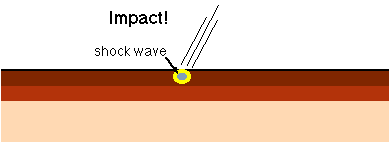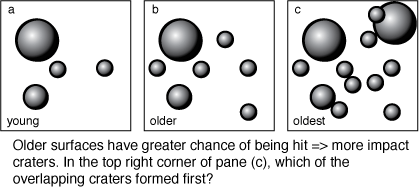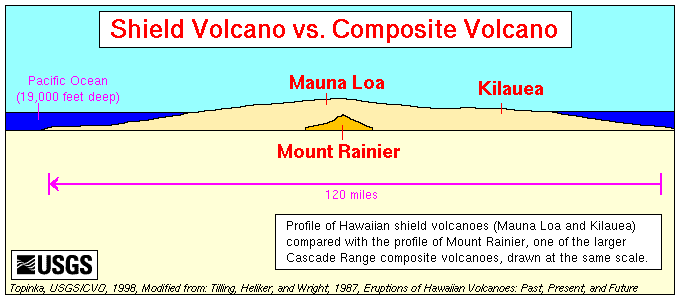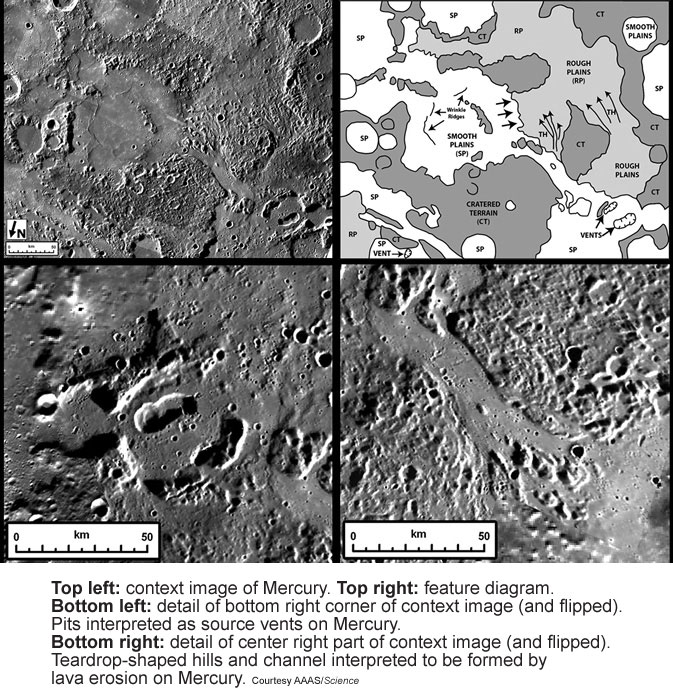
Video lecture for Geology section
Terrestrial planets have hard surfaces that can be re-shaped by several different processes: impact cratering, volcanism, erosion, and tectonics.
There are still small chunks of rock orbiting the Sun left over from the formation of the solar system. Some of them have orbits that cross the orbits of the planets and moons. When they get close enough to a planet or moon, they will be pulled in by the large body's gravity and strike the surface at a speed of at least the escape velocity of the planet or moon, i.e., faster than a bullet. At such speeds, the projectile explodes on impact and carves out a round bowl-shaped depression on the surface. This process is impact cratering. How can you distinguish an impact crater from a volcanic crater?
Volcano craters are above the surrounding area on mountaintops while the craters from impacts are below the surrounding area with raised rims. The craters on all of the moons except Io, Mercury, and most of the ones on Mars are from impacts. The kinetic energy of the impacting meteorite or asteroid is converted into heat, sound, and mechanical energy---the projectile explodes on impact. The explosion is what carves out the crater so almost all craters are round (otherwise the great majority would be oblong in shape). See the "Not Round" page from the THEMIS site for what can make an impact crater not round (links will appear in a new window).
The rock on the surface of the planet or moon is bent backward, upward, and outward so the amount of material ejected is much larger than the projectile. Large craters will have a central peak formed by the rock beneath the impact point rebounding upward and they may also have terracing of the inner walls of the crater from the collapsing of the crater rim inward. The size of the craters having central peaks depends on the gravity of the planet or moon: on the Moon craters larger than about 60 kilometers in diameter have central peaks while the crater diameter on the Earth needs to be larger than just 1 to 3 kilometers.

Impact cratering was especially prevalent for the first several hundred million years after the planets formed as the planets swept up left-over material. The last stage of that "sweeping up", called the late heavy bombardment, occurred from about 4.1 to 3.8 billion years ago. Impacts as large as the one that led to the demise of the dinosaurs in much more recent history were happening about once a month. Most of the impact basins---craters measured in hundreds of kilometers---were made during this time. It is noteworthy that about the time the heavy bombardment ended, life took hold. The oldest fossil evidence of ancient organisms dates back to 3.5 billion years ago and evidence for biological activity based on isotopic ratios of carbon may date back to about 3.85, even up to 4.2 billion years ago, though the carbon isotope ratio evidence is controversial.
The number of craters per unit area on a surface can be used to determine an approximate age for the planet or moon surface if there is no erosion. The longer the surface has been exposed to space, the more craters it will have. If you know how frequently craters of a given size are created on a planet or moon, you can just count up the number of craters per unit area. This assumes, of course, that the cratering rate has been fairly constant for the last few billion years. The heavy bombardment of about 3.8 billion years ago must be taken into account when using the crater age dating technique. For example, the highland regions on the Moon have ten times the number of craters as the maria, but radioactive dating (explained in the next chapter) shows that the highlands are approximately 500 million years older than the maria, not ten times older. At a minimum, crater-age dating can tell you the relative ages of surfaces (which surface is older than another). Careful studies of how the craters overlap other craters and other features can be used to develop a history or sequence of the bombardment on the moons and planets.

Another technique developed recently for dating craters on the Moon uses the fact that younger craters have more large rocks on their surface than older craters (micrometeorite impacts grind down rocks over long periods of time) and larger rocks take more time to cool off during the night. Therefore, younger craters will take longer to cool off at night than older rocks. This technique works for craters that are up to about a billion years old. A study announced in 2019 using this new technique found that the rate of asteroid impacts on the Moon increased by about 2.6 times starting about 290 million years ago and a careful analysis of craters on specially-chosen places on Earth with little erosion in the past 650 million years showed the same increase. We don't know yet what caused the increase in the impact rate.
All bodies with hard surfaces have impact craters. Worlds with less volcanism or erosion or tectonic activity in their history will retain more impact craters since the planet formed. Worlds with more geological or erosional activity will have newer surfaces or craters that have been so worn away as to be unrecognizable. Earth has over 180 impact craters on its continents with the 1.2-km diameter Meteor Crater in northern Arizona being one great, well-preserved example. Even Venus with its thick atmosphere has impact craters, though they all have diameters measured in kilometers because smaller projectiles burn up in its atmosphere.
|
The first frame of a 3D movie flyover of Tycho Crater on the Moon as seen by Kaguya. Tycho is 85 kilometers wide. It displays the classic terraced crater walls and central peak of a complex crater. Select the image to go to the Selene website for a great flyover of the crater. LPI website with movie link (requires Flash, now see if video posted on YouTube) |
Victoria Crater on Mars as seen by the Mars Reconnaissance Orbiter. Victoria is 800 meters in diameter. It is a simple crater that has been partially filled in with sand---note the sand dunes on its floor. If you download the full-resolution version of this picture from the link on the picture, you will be able to see the rover, Opportunity next to the top left crater rim. |
Cunitz Crater is the 48.5-km diameter crater in the foreground of this 3D perspective view of Eistla Regio on Venus as seen by Magellan. In the distance is the 3-km high volcano Gula Mons. |
Volcanism is any eruption of molten lava onto the surface. The molten rock has a lower density than solid rock so it rises. Also the pressure from the surrounding solid rock squeezes the molten rock upward. Molten rock contains trapped gases that expand as it rises causing it to rise even faster. The structures that result from erupting lava depend on the thickness and density of the lava.

Very thick, low-density lava can make steep-sided stratovolcanoes (also called composite volcanoes) like the Cascade volcanoes in Oregon and Washington and Mt Fuji in Japan. The lava does not flow as far as the other two types, so their diameters are not as great as the other types. They are common on the Earth. The "pancake domes" on Venus may be considered a type of stratovolcano but their shapes are much more cylindrical without a peak.

Mt Shasta is near the southern end of the Cascade Range of volcanoes.

Mauna Loa is a shield volcano on the Island of Hawaii. It is the largest volcano on the Earth. Note the much gentler slope than what Mt Shasta has. This picture was taken from a much greater distance than the Mt Shasta picture above.
If the lava is made of thinner, higher density material called basalt, the volcanoes will be much wider in diameter. Thicker basalt will make shield volcanoes like the Hawaiian volcanoes, Sif Mons on Venus, and Olympus Mons on Mars. These types of volcanoes are found throughout the solar system. Besides being very wide in diameter, shield volcanoes can also be very tall---from its base below the ocean surface to its peak, Mauna Kea and Mauna Loa are taller than Mt Everest. Olympus Mons is about three times taller than Mt Everest (24 km above the surrounding plains) and would cover up most of Texas (about 600 km in diameter).

(image no longer found on USGS volcanoes website )

Medicine Lake Volcano profile along the horizon line (has several vents along its side to make the knobby appearance).
Although the stratovolcanoes (composite volcanoes) in the Cascade volcanic arc get most of the attention because of their vertical height and spectacular appearance, shield volcanoes make up the great majority of the volume of the Cascade volcanic arc. The image below compares Mt Shasta with Medicine Lake Volcano. Both volcanoes in northern California are part of the Cascade volcanic arc. (Models are in the exhibits at Lava Beds National Monument.) Many other shield volcanoes are smaller than Mt Shasta.
The thinnest, runniest basalt will make lava plains that can re-shape the surface by covering up things. Lava plains are found here and elsewhere in the solar system. For example, large lava flows covered up most of modern-day eastern Washington and northeastern Oregon with a layer more than 1.5 kilometers thick. The dark mare on the Moon are basalt lava plains that filled in giant impact basins approximately 3.5 billion years ago. Mercury has lava plains that formed after the late heavy bombardment when it was still geologically active. Much of Venus is covered in lava plains.
 (image no longer found on USGS Volcanoes website) |
 |
Volcanism also adds gases to a planet's atmosphere either explosively during a volcanic eruption such as Mt St Helens in Washington or Mt Pinatubo in the Philippines, or more quietly as in the volcanic vents in Hawaii and Yellowstone in Wyoming (Yellowstone pictures link). This outgassing is what created the terrestrial planets current atmospheres (Earth's has undergone further significant processing through the action of life). See the Smithsonian Institution's Global Volcanism Program website for more about the Earth's volcanoes.
Erosion is the breaking down or building up of geological structures and transporting of material (rock for our purposes here) by ice, liquid, or wind. Water ice in the form of glaciers carves out bowl-shaped valleys such as Yosemite in California and those in Glacier National Park in Montana. Glacial moraines form from gravel transported by glaciers. The gravel comes from the glacier scraping rock and it gathers along the side (lateral moraine) and front (terminal moraine) of the glacier. When these rivers of ice merge with other glaciers, one individual glacier's lateral moraine can merge with another glacier's lateral moraine to make a medial moraine. The result is a curvy striped pattern like that shown in the image below.
When the glacier recedes the gravel piles from the side and front of the glacier remain. One classic example is Wallowa Lake in the northeastern corner of Oregon. Liquid water on the Earth has carved through layer upon layer of rocks to produce such spectacular things as the Grand Canyon on Earth. Valleys carved by liquid water have much sharper V-shapes than glacial valleys. Erosion by liquid water on Mars in the past is responsible for river drainage channels but the sublimation of carbon dioxide on the walls of impact craters seems to cause rock and soil to flow downhill to make the gullies seen on crater walls as illustrated by this particularly sharp image taken of the side of Newton Crater by the Mars Global Surveyor. The crater rim is on the right and the crater floor is on the left.
On Titan, the largest moon of Saturn, liquid methane has carved features into the ground made of frozen water that are quite reminiscent of features on Earth. Below is a synthetic aperture radar image from Cassini of a canyon system on Titan. Fluids flowed from high plateaus on the right to lowland areas on the left. All of the tributaries suggest that methane rainfall is effectively eroding the surface. Liquid rock (lava) can also cause erosion---see the Mercury image in the volcanism section above for one nice example.
Wind picks up small sand particles on a planet's surface and strikes it against a hard surface to chip pieces of it away (to make more sand!). The winds can also shape hills of sand into sand dunes as seen on the Earth, Mars, and Titan. Image below links to originals (and much larger versions): Mars dunes -- Titan dunes.

The agents of erosion can, of course, work together. Water expands when it freezes so when it trickles into cracks in rocks and freezes during the winter, it can enlarge the cracks enough to separate the minerals from each other. (Plant roots do the same thing as well.) Liquid water from rainfall and snowmelt takes those minerals down to the oceans---a process which also helps to remove carbon dioxide from the atmosphere. Wind whittles away the exposed rock left behind and the result can be beautiful formations like Bryce Canyon in Utah.
Besides chipping away at mountains and other rises in the land bit by bit, erosion can also add to formations by depositing sediments when liquid slows down enough for the suspended sediments to sink to the stream or river bed such as the Mississippi River Delta and the Lena River Delta in Russia (shown below). Fossilized river deltas are seen on Mars.
Tectonics is any stretching or compression of the lithosphere. Usually tectonic activity is due to convection in the mantle below the lithosphere but it can occur when an especially massive landform such as a volcano makes the lithosphere under it buckle from its weight or a rising plume of extra hot material in the mantle pushes on the lithosphere overhead to make a bulge such as coronae features on Venus and possibly the Tharsis Bulge on Mars (though that one may be due to mantle convection long ago).
|
Aine Corona on Venus as seen by Magellan. Aine Corona is approximately 200 kilometers across. Just north of Aine is a 35-km diameter "pancake" dome feature made from extremely viscous (thick) lava. Another pancake dome is inside the western ring of the corona's fractures. Pancake domes are a type of volcanic structure seen only on Venus. |
Tharsis Bulge side of Mars as seen by the Viking 1 orbiter shows the true "Grand Canyon" of the solar system, Valles Marineris, a huge fracture that probably formed as that side of Mars was raised up. Valles Marineris would stretch across the entire United States with a bit left over. To the west (left) are large shield volcanoes on Tharsis each about 25 kilometers high. Select the "Valles Marineris" link to the Mars Odyssey THEMIS website for an excellent flyover of Valles Marineris. |
Mercury has high cliffs (as tall as 3 km) called "lobate scarps" that run for hundreds of kilometers that are probably the result of the shrinking of Mercury as it cooled from its formation. Recall that Mercury has the proportionally largest metallic core of the planets. As the metallic core cooled, it shrank and the mantle and brittle crust would have had to shrink too, crinkling in the process. The image below from MESSENGER's first flyby of Mercury indicates that the volcanic flows in Mercury's early history occurred while the crinkling was going on. The two smaller white top arrows point to a scarp that formed after the lava plain flow had filled in a number of the craters. The bottom three larger white arrows point to a possible older scarp against which the lava plain flow stopped. The black arrow points to a small crater that formed after the top lobate scarp. The image is from a NY Times article which in turn used images from the July 4, 2008 issue of Science. The filled in impact crater at center left (with the second small white arrow and black arrow) is about 100 km across. See NASA/JPL's Photojournal for more information about the wrinkle ridges inside the crater that formed when the lava plain flow solidified.

A special type of tectonic activity unique to Earth in our solar system is called "plate tectonics". It is the major agent of changing the Earth's surface and plays a key role in keeping the Earth habitable. It warrants its own section of discussion.
![]() Go back to previous section --
Go back to previous section --
![]() Go to next section
Go to next section
last updated: June 3, 2022